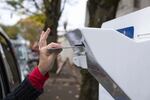A new study says Oregon’s path-breaking automatic voter registration system helped make the state’s voting population more diverse.
A study co-authored by Paul Gronke, a Reed College political scientist and expert on voting issues, found that automatically registering voters through the DMV helped bring in more under-represented groups. In particular, it led to more voting by ethnic minorities, younger people and those who are low-income and more rural.
"This report finds significant demographic and geographic differences between these newly registered voters and those who registered through traditional means," said the study, prepared for the Center for American Progress, a Washington, D.C., think tank.

A voter drops off a ballot at a Multnomah County dropbox in November 2016.
Ann McGarry / OPB
The study projected that Oregon's new system added to the voting rolls about 116,000 new people who would have been unlikely to register by traditional means. And about 40,000 of those "previously disengaged people" voted in November, according to the study.
That's a relatively modest addition to the voting rolls. All told, more than 2.5 million Oregonians were registered to vote in November and just over 2 million cast a ballot. Still, supporters have promoted the "motor voter" law as a way to increase turnout at a time when there is controversy over laws in some states that have the effect of making it harder for some people to vote.
In 2015, Oregon became the first state to pass the system dubbed “motor voter” — it automatically signs up voters when they get a driver’s license or register a car. Prospective voters are given the chance of opting out.